
A world where we work, learn, play, relax, and eat with robots every day
How Will Robotics Change Retail and Food Service in 2030/2040?
Retail and Food Service Industries Suffer Extremely Low Labor Productivity and Labor Shortage
It is often said that productivity is low in Japan across all industries compared to other developed countries. Most notably, the service industry, retail and food services in particular, has very low labor productivity. Data published by the Ministry of Internal Affairs and Communications (MIC) in “Cross-Industry Comparison Based on Economic Census and Management Indicators” also show that both the retail and food service industries have low productivity even within the tertiary sector. The amount of value added per worker in the retail and food service industries is only about 60% and 30%, respectively, of that in the manufacturing industry (Figure 1).
Cross-Industry Comparison of Labor Productivity (Value Added per Worker)
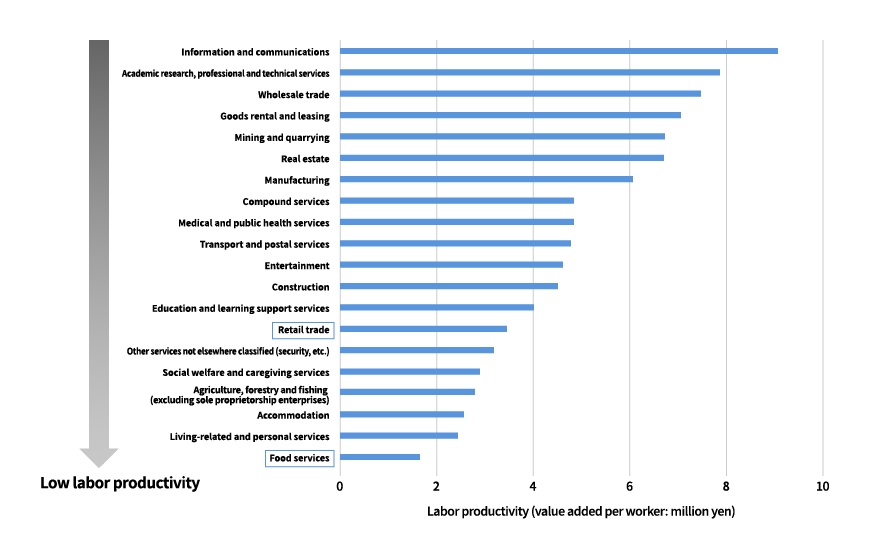
Source: Created by Mitsubishi Research Institute based on MIC’s “Cross-Industry Comparison Based on Economic Census and Management Indicators” (2012)
On the other hand, according to the Employment Security Statistics from the Ministry of Health, Labour and Welfare (MHLW), the jobs-to-applicants ratio (including part-time jobs) for merchandise sales workers and food and drink preparatory workers has continued to be high indicating that the retail and food service industries have routinely experienced labor shortages (Figure 2).
Jobs-to-Applicants Ratio (Regular Jobs Including Part-Time)
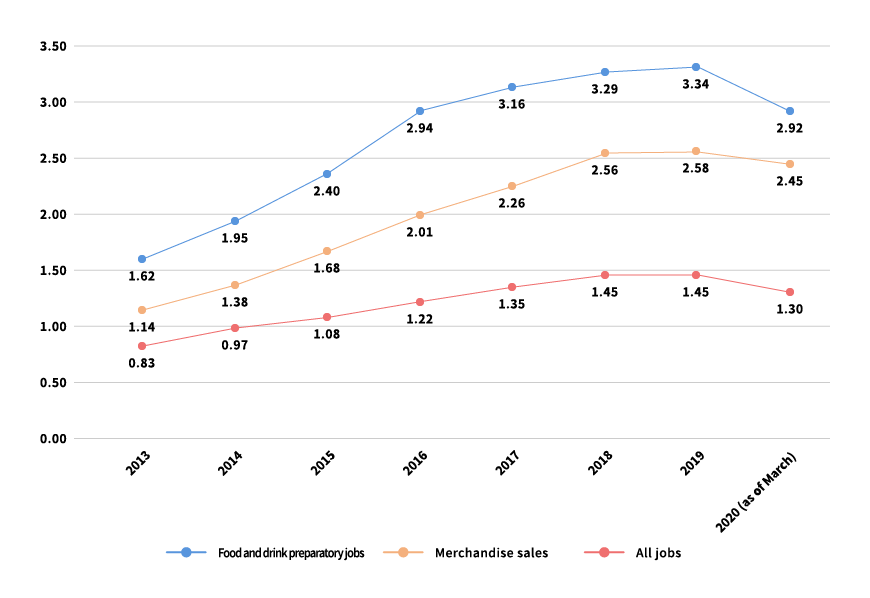
Source: Created by Mitsubishi Research Institute based on MHLW’s “Employment Security Statistics”
Current Status of Robot Installation in the Retail and Food Service Industries
In previous columns, we have looked into trends in various industries trying to overcome labor shortages and inefficiencies by introducing robotics. However, the application of robotics has been slow in retail and food services.
A questionnaire survey titled “Corporate Awareness on New Technologies and Human Resource Utilization Toward Improving Productivity” was conducted by the Cabinet Office to 2,327 companies operating in diverse industries in Japan. The results showed that the application of robotics in the retail and food service industries is second to last, ahead of only agriculture (Figure 3).
Introduction of New Technologies Including Robotics by Industry
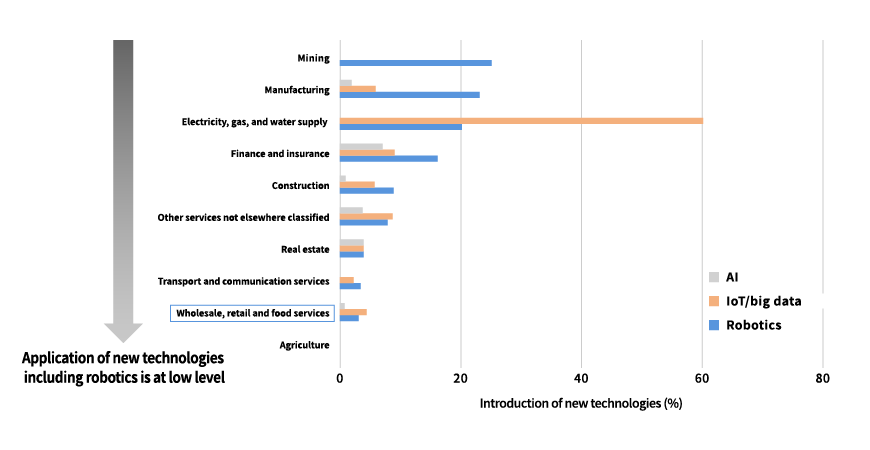
※Results of a questionnaire survey to 2,327 companies in Japan
Source: Created by Mitsubishi Research Institute based on the Cabinet Office’s “Corporate Awareness on New Technologies and Human Resource Utilization Toward Improving Productivity” (2017)
There are some obvious reasons why the application of robots was particularly slow in the retail industry. First of all, retail work entails a wide range of tasks from displaying goods and managing inventory to attending customers, handling payment, and cleaning. Moreover, the merchandise items sold in retail stores are wide ranging and small lot with diverse shapes and sizes and rapidly changing in variety. With these conditions, robots may not be very cost effective on an individual basis, which is discourages their application.
Expansion of Robotics due to Increasing Needs for Contact-Free Services
However, the outbreak of the novel coronavirus (COVID-19) which emerged in the city of Wuhan, China and in no time became a global pandemic in 2020 appears to be boosting the application of service robots. Services provided through direct interaction between people was the mainstream in the retail and food service industries. With the spread of COVID-19, however, people are changing their lifestyles and behavior to avoid direct contact with other people as much as possible when buying things or seeking food services. There have been attempts in the past to experimentally use robots for attending customers or serving food. There have also been some cases of unmanned stores and unattended payment terminals. It seems that the current pandemic is set to accelerate the adoption of these solutions.
In this study, we have summarized the status and trends concerning the application of AI, IoT and robot solutions at each step (customer service/store operation, payment, and management) of the value chain in the retail and food service industries (Figure 4). There are many payment solutions that have already reached commercial application and unmanned cash registers are now being adopted in stores. Meanwhile, although we have seen the development of attendant, cooking and server robots, it will take some more time until robots become fully ready for practical application in customer service and operations. At the management step of the value chain such as merchandise, employee, and store management, robot solutions have not been implemented, particularly in inventory management and displaying merchandise items which are the most labor consuming tasks in retail stores.
Status and Trends Concerning Robot Application in the Value Chain of the Retail and Food Service Industries
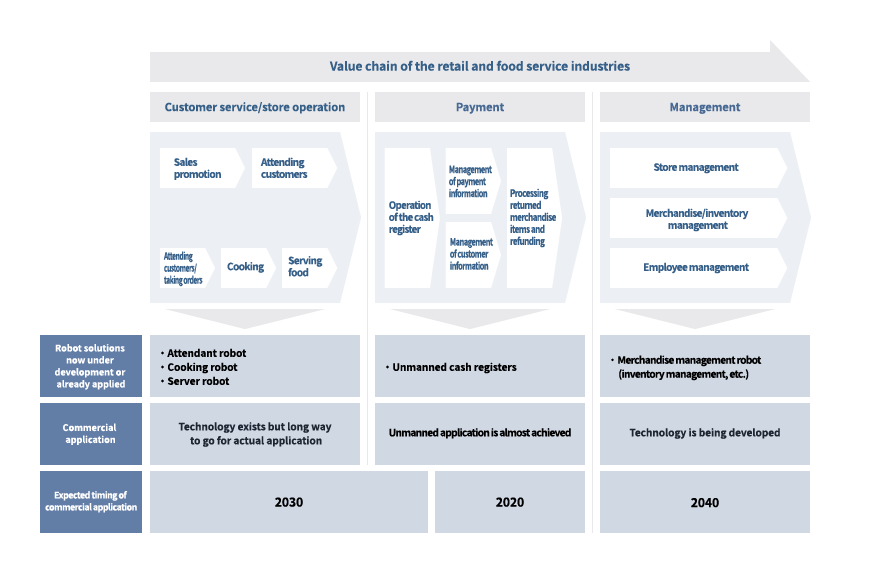
Source: Mitsubishi Research Institute, Inc.
Examples of Robots Used in the Food Service Industry
With regard to cooking, robots are being developed to the level of performing not only a part of the cooking process but the entire process until the food is ready to be served. In China, where labor costs are rapidly rising, 20,000 server robots are sold annually (Figure 5).
Examples of a Cooking Robot and a Server Robot
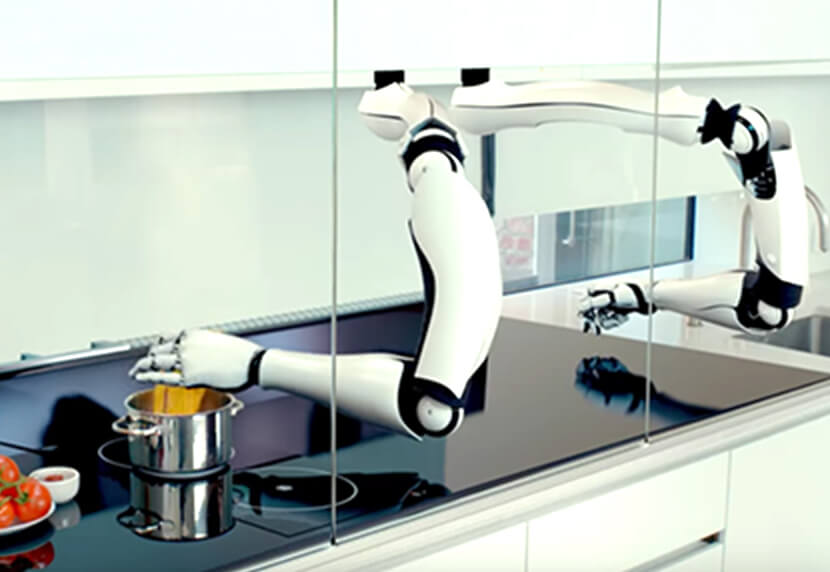
Jointly developed by Moley Robotics and Shadow Robot Company in the UK, the robot is mounted with 129 sensors and 20 motors and comprised of two robotic hands attached to the kitchen ceiling. The hands handle cooking utensils in a smooth and sophisticated manner. With 2,000 different types of cooking processes pre-programmed, the robot can provide a range of support from simple cooking to performing the entire cooking process, according to the instructions given by the user.
Photo provided by Moley Robotics
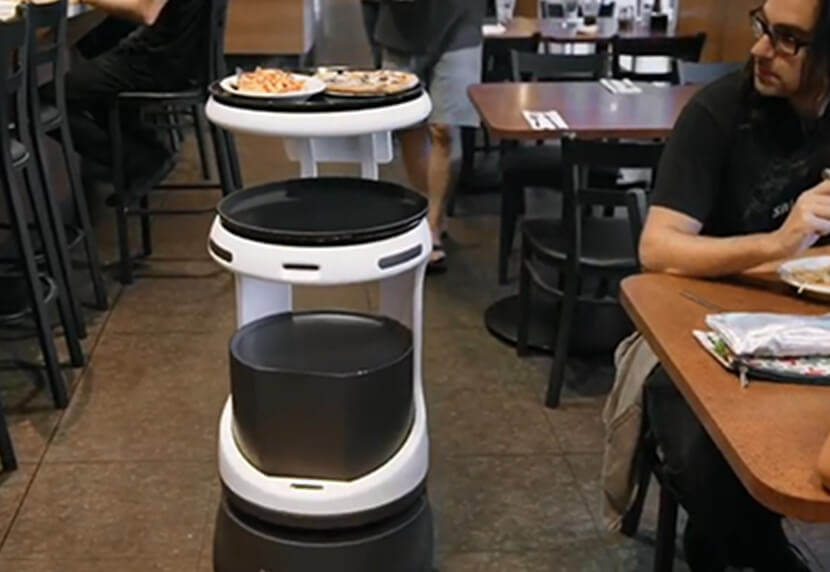
Penny is expected to bring food to tables and collect used plates after eating. Penny is programmed to approach the table when customers sitting there press an order button on a touch pad like the ones you see at conveyor-belt sushi restaurants and franchised family restaurants.
Photo provided by Bear Robotics
Examples of Robots Used in the Retail Industry
While unmanned stores are still at an experimental level, validation tests of unmanned cash registers and other solutions are underway. With regard to such tasks as inventory management and display of goods, merchandise management based on image recognition technology and radio frequency identification (RFID) is spreading. For instance, by assigning a RFID tag to each item sold, retail stores can not only simplify inventory management, but scan multiple items at once for payment, shoplifting prevention, and store inventory status checks in real time. Displaying goods on store shelves, however, still needs to be carried out by humans, as automation of this task has never reached the validation stage. It will take a considerable amount of time for the realization of a completely unmanned store.
Examples of an Unmanned Store and an Inventory Management Robot
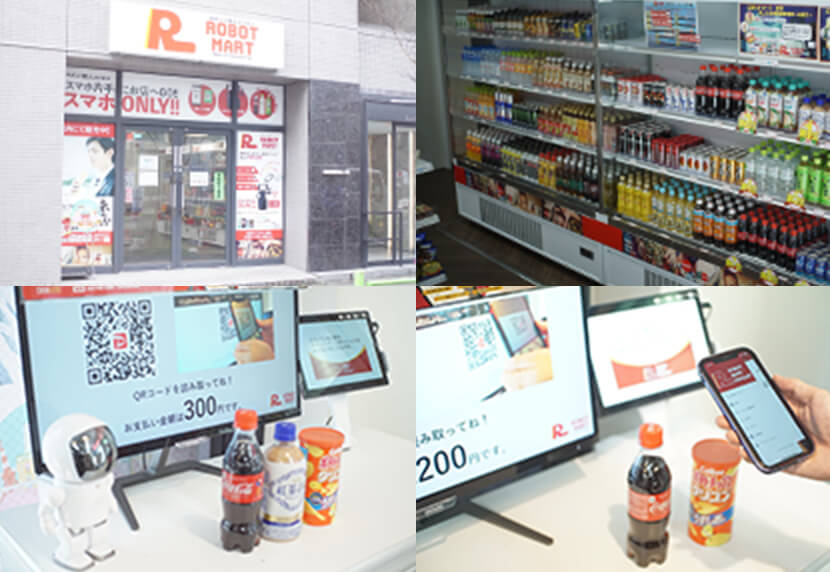
When entering the store, you hold up your smartphone at the entrance gate to have your QR code scanned. Once your smartphone information has been authenticated, you can freely look around and pick up the goods you wish to buy. When leaving the store, the computer will read in the goods you have chosen by image recognition and the payment is handled automatically.
Photo provided by Robot Security Police, Ltd.
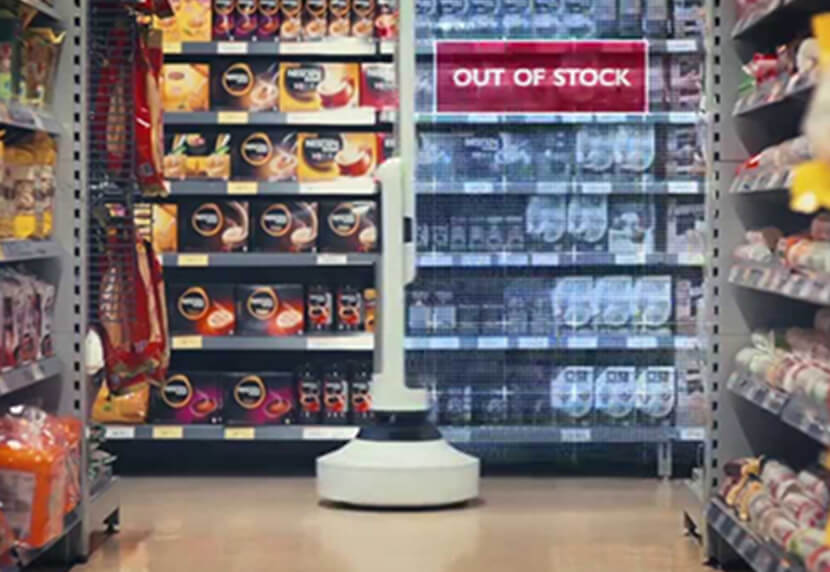
Tally can notify retail employees when shelves are empty or when they have run out of stock. It also checks and collects data on whether products are displayed on the right shelf in the right direction and whether they are listed at the right price.
Photo provided by Simbe Robotics, Inc.
The Future of Robot Utilization in the Retail and Food Service Industry
The Future of Mass-Market Retail Stores
We believe most tasks except refilling of store shelves will be automated in mass-market retail stores by around 2030. Customers will hold up their smartphone or other devices at the entrance gate to have their QR code scanned, and payment will be handled automatically at unmanned cash registers (Figure 7). It is anticipated that the majority of cash registers will be unmanned by 2030. Image recognition systems that identify purchased items will be ready for commercial use by then, but may take longer for widespread adoption as such systems will be quite expensive. Fully automated stores with robots capable of refilling store shelves and managing inventory are expected to be realized by around 2040. At such stores, customers will be authenticated using face recognition technology and image recognition will be widely used to identify which goods the customer chose to purchase, so the payment will be automatically settled when the customer walks out of the store with the purchase in a bag.
Image of a Mass-Market Retail Store in 2030
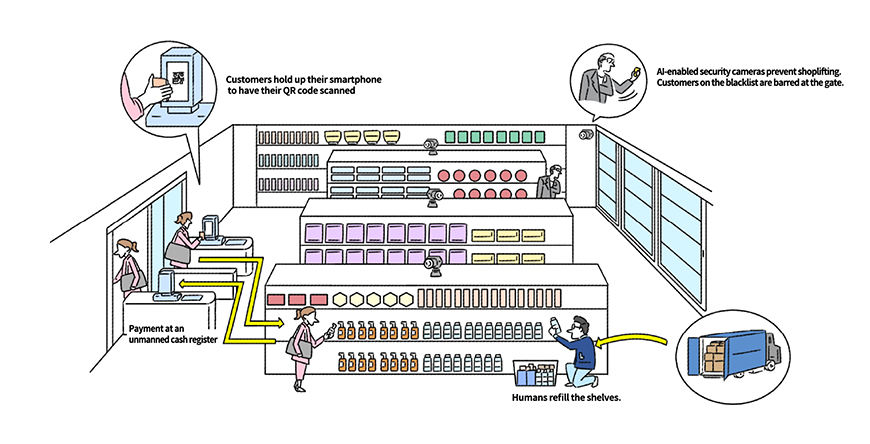
Source: Mitsubishi Research Institute, Inc.
The Future of Luxury Retail Stores
Luxury stores, on the other hand, will utilize technologies to raise the quality of customer service by salesclerks and offer customers the kind of satisfaction they can only experience by physically visiting the store, as a means of competing with online shopping and unmanned stores (Figure 8). Customer data will be accumulated and, before the customers arrive at the store, the salesclerks will already know their taste and the purpose of their visit. AI will observe the customer’s behavior inside the store and advise the clerks on appropriate suggestions to make to customers. At apparel stores, body size will be 3D-scanned and customers will be able to try on clothes in virtual reality. They can even choose a dress suitable for the destination of their next trip. Customer data necessary for made-to-order items will be immediately sent to the factory, so that customers can receive the product as soon as possible and at the place where they specify.
Image of a Future Luxury Retail Store
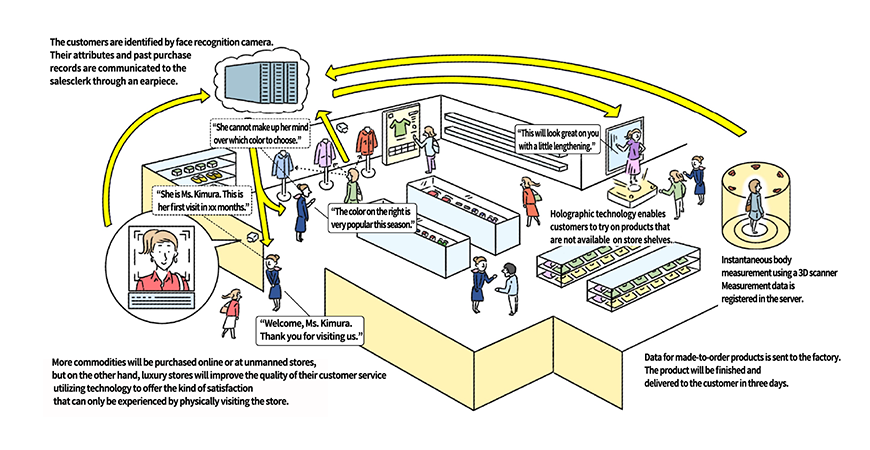
Source: Mitsubishi Research Institute, Inc.
The Future of Mass Market Restaurants
People and robots will be working together in a mass market restaurant in 2030. Customers will enter the restaurant using smartphone QR scanning, as in retail stores. Tablet-based order systems will become mainstream but customers may be recommended certain menus if needed. The order will be immediately sent to the kitchen, where labor consuming tasks such as chopping and preparing ingredients will be performed by robots while the chefs focus on more delicate tasks such as finishing a dish to serve high quality meals. Server robots will deliver food to customers most of the time.
By around 2040, many mass market restaurants will be nearly unmanned. Needless to say, customers will be authenticated by face recognition upon entering the restaurant. The entire cooking process will be performed by robots that can adjust how the food is prepared according to the customer’s taste (Figure 9).
Images of a Mass Market Restaurant in 2030 and 2040.
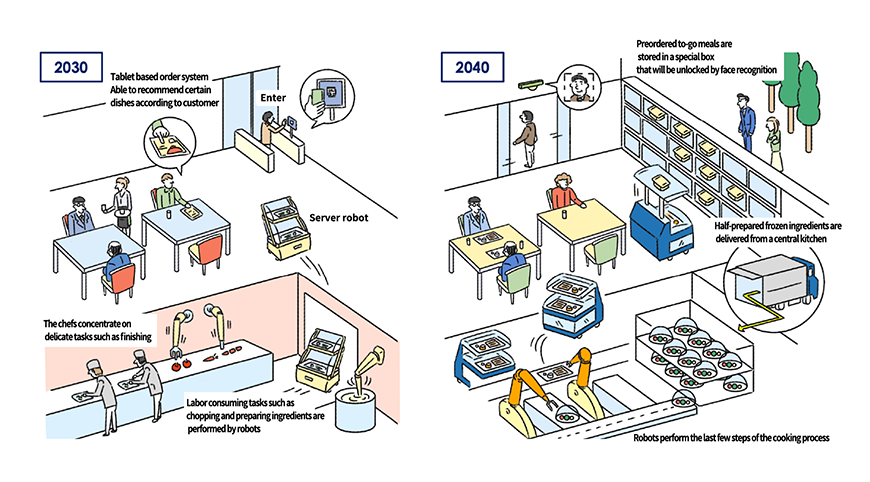
Source: Mitsubishi Research Institute, Inc.
Problems to Overcome in Developing Robot Technology
We will see more robots working in the retail and food service industries and more stores and restaurants will become completely automated in the future. However, there are some challenges to overcome to facilitate these developments.
Stores and Restaurants Will Lack Individuality
The adoption of low-cost and standardized packaged systems will make it easier for companies to copy business models, leading to a lack of individuality among companies and stores. It may be that retail stores and restaurants (especially those targeted at the mass market) become increasingly standardized. On the other hand, some restaurants may thrive by differentiating from others and offering unique value such as original menus or the restaurant owner’s attractive personality.
Increased standardization and lack of individuality may be inevitable among convenience stores and supermarkets that people use on a daily basis. Stores will need to differentiate by planning unique events that will satisfy customers. Meanwhile, luxury stores will need to enhance the value of customer service through human interactions, rather than by automating all operations.
Business Continuity Risks Caused by Too Much Reliance on Robotics
Completely automated stores and restaurants run the risk of complete business suspension when the telecommunication system or cloud service fails because all store operations including the automatic door, customer service, and payment are reliant on such systems. It is necessary to build a business structure and workflow to enable humans to take over the operations in the case of a contingency. It is also important to design a fail-safe structure such as having on-premise backup systems rather than relying solely on cloud services.
Building an Optimal Environment for the Operation of Robots
As with the other industries we have examined so far, the workflow and layout of retail and food service industries are designed to optimize human performance. Application of robots can be facilitated by redesigning and optimizing the workflows and work environment for the operation of robots. Robots can do many things that are impossible for human beings (like turning their head 360 degrees, working without feeling fatigue, moving at high speed, etc.). We need to fully understand the characteristics of robots to investigate what kind of environment would draw out their best qualities.
